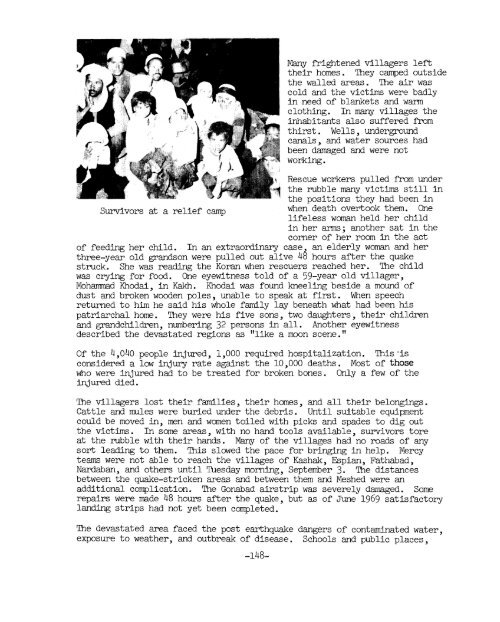3. - usaid
3. - usaid
3. - usaid
You also want an ePaper? Increase the reach of your titles
YUMPU automatically turns print PDFs into web optimized ePapers that Google loves.
Many frightened villagers left<br />
their homes. They camped outside<br />
the walled areas. The air was<br />
cold and the victims were badly<br />
in need of blankets and warm<br />
clothing. In many villages the<br />
inhabitants also suffered from<br />
thirst. Wells, undergroimd<br />
canals, and water source:j had<br />
been damaged and were no't<br />
working.<br />
Rescue workers pulled from under<br />
the rubble many victims still in<br />
the positions they had been in<br />
Survivors at a relief camp when death overtook them. One<br />
lifeless woman held her child<br />
in her m; another sat in the<br />
corner of her room in the act<br />
of feeding her child. In an extraordinary case, an elderly woman and her<br />
three-year old grandson were pulled out alive 48 hours after the quake<br />
struck. She was reading the Koran when rescuers reached her. The child<br />
was crying for food. One eyewitness told of a 59-year old villager,<br />
Mohammad Khodai, in Kakh. Khodai was found kneeling beside a mound of<br />
dust and broken wooden poles, unable to speak at first. When speech<br />
returned to him he said his whole family lay beneath what had been his<br />
patriarchal home. They were his five sons, two daughters, their children<br />
and grandchildren, numbering 32 persons in all. Another eyewitness<br />
described the devastated regions as "like a moon scene."<br />
Of the 4,040 people injured, 1,000 required hospitalization. This is<br />
considered a low injury rate against the 10,000 deaths . Most of those<br />
who were injured had to be treated for broken bones. Only a few of the<br />
injured died.<br />
The villagers lost their families, their homes, and all their belongings.<br />
Cattle and mules were buried under the debris. Until suitable equipment<br />
could be moved in, men and women toiled with picks and spades to dig out<br />
the victims. In some areas, with no hand tools available, survivors tore<br />
at the rubble with their hands. Many of the villages had no roads of' any<br />
sort leading to them. This slowed the pace for bringing in help. Mercy<br />
teams were not able to reach the villages of Kashak, Espian, Fathabad,<br />
Nardaban, and others until Tuesday morning, September <strong>3.</strong> The distances<br />
between the quake-stricken areas and between them and Meshed were an<br />
additional complication. The Gonabad airstrip was severely damaged. Some<br />
repairs were made 48 hours after the quake, but as of June 1969 satisfactory<br />
landing strips had not yet been completed.<br />
The devastated area faced the post earthquake dangers of contaminated water,<br />
exposure to weather, and outbreak of disease. Schools and public places,
















